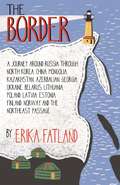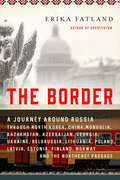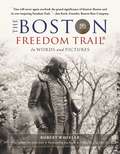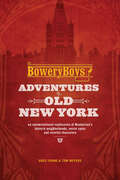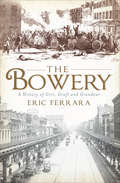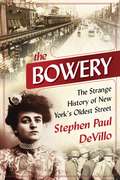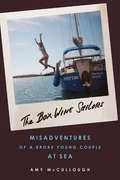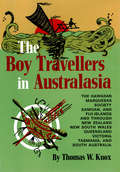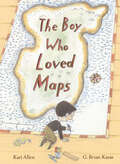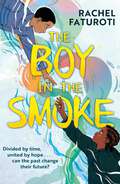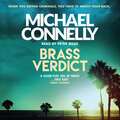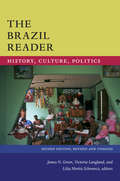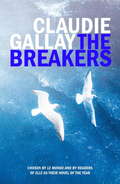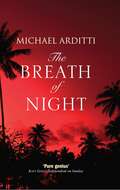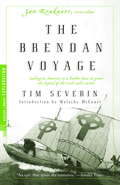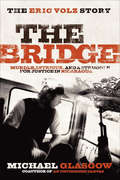- Table View
- List View
The Border - A Journey Around Russia: SHORTLISTED FOR THE STANFORD DOLMAN TRAVEL BOOK OF THE YEAR 2020
by Erika FatlandA journey along the seemingly endless Russian border - from North Korea in the Far East through Russia's bordering states in Asia and the Caucasus, crossing the Caspian Ocean and the Black Sea along the way."Erika Fatland [is] shaping up to be one of the Nordics' most exciting new travel writers" National Geographic**SHORTLISTED FOR THE STANFORDS DOLMAN TRAVEL BOOK OF THE YEAR 2020**"A hauntingly lyrical meditation to the contingencies of history" Wall Street Journal"[An] impressive mix of history, reportage and travel memoir" Washington PostThe Border is a book about Russia and Russian history without its author ever entering Russia itself; a book about being the neighbour of that mighty, expanding empire throughout history. It is a chronicle of the colourful, exciting, tragic and often unbelievable histories of these bordering nations, their cultures, their people, their landscapes.Through her last three documentary books - one about terrorism in Beslan, one about the 2011 terror attacks in Norway and one about post-Soviet Central Asia - social anthropologist Erika Fatland has established herself as a sharp observer and an outstanding interviewer at the forefront of Nordic non-fiction.Translated from the Norwegian by Kari Dickson
The Border - A Journey Around Russia: SHORTLISTED FOR THE STANFORD DOLMAN TRAVEL BOOK OF THE YEAR 2020
by Erika FatlandA journey along the seemingly endless Russian border - from North Korea in the Far East through Russia's bordering states in Asia and the Caucasus, crossing the Caspian Ocean and the Black Sea along the way."Erika Fatland [is] shaping up to be one of the Nordics' most exciting new travel writers" National Geographic**SHORTLISTED FOR THE STANFORDS DOLMAN TRAVEL BOOK OF THE YEAR 2020**"A hauntingly lyrical meditation to the contingencies of history" Wall Street Journal"[An] impressive mix of history, reportage and travel memoir" Washington PostThe Border is a book about Russia and Russian history without its author ever entering Russia itself; a book about being the neighbour of that mighty, expanding empire throughout history. It is a chronicle of the colourful, exciting, tragic and often unbelievable histories of these bordering nations, their cultures, their people, their landscapes.Through her last three documentary books - one about terrorism in Beslan, one about the 2011 terror attacks in Norway and one about post-Soviet Central Asia - social anthropologist Erika Fatland has established herself as a sharp observer and an outstanding interviewer at the forefront of Nordic non-fiction.Translated from the Norwegian by Kari Dickson
The Border: A Journey Around Russia Through North Korea, China, Mongolia, Kazakhstan, Azerbaijan, Georgia, Ukraine, Belarus, Lithuania, Poland, Latvia, Estonia, Finland, Norway, and the Northwest Passage
by Erika FatlandThe acclaimed author of Sovietistan travels along the seemingly endless Russian border and reveals the deep and pervasive influence it has had across half the globe.Imperial, communist or autocratic, Russia has been—and remains—a towering and intimidating neighbor. Whether it is North Korea in the Far East through the former Soviet republics in Asia and the Caucasus, or countries on the Caspian Ocean and the Black Sea. What would it be like to traverse the entirety of the Russian periphery to examine its effects on those closest to her? An astute and brilliant combination of lyric travel writing and modern history, The Border is a book about Russia without its author ever entering Russia itself. Fatland gets to the heart of what it has meant to be the neighbor of that mighty, expanding empire throughout history. As we follow Fatland on her journey, we experience the colorful, exciting, tragic and often unbelievable histories of these bordering nations along with their cultures, their people, their landscapes. Sharply observed and wholly absorbing, The Border is a surprising new way to understand a broad part our world.
The Boston Freedom Trail: In Words and Pictures
by Robert WheelerA Moving and Informative Guidebook and Keepsake Worthy of Coffee Table Display!Through lyrical paragraphs and poignant black and white images, The Boston Freedom Trail reveals the essence of each site along the Freedom Trail, thereby allowing the reader to be moved and to connect more intimately with the splendor of liberty itself. Said to be the soul of the city, Boston’s Freedom Trail embodies the remarkable and courageous spirit of America’s unyielding quest for Independence and makes Boston a popular and endearing tourist destination. Beginning within the elegantly manicured grounds of Boston’s Common, this trail takes an estimated twenty million visitors a year on a fascinating 2.5-mile walk through its historic sites—sites enveloped within the city itself, and dotted with cafés, restaurants, bars, hotels, and commerce. In this book, each of these sites, and each name associated with America’s independence, whispers endless stories and inspires great dreams. This city’s captivating past—and that of the entire American experience—can be discovered on each page, making it an absorbing and everlasting book, one dedicated to the absolute beauty and the luminous tradition of freedom.
The Boundless River: Stories from the Realm of the Rhine
by Mathijs Deen"A beautiful book, by turns poetic, witty and full of learning . . . This unique biography of a river marks a new kind of writing about people and place, both in and out of time" PATRICK McGUINNESSThe Boundless River takes the reader into a unique world ‒ the twilight zone between fact and fiction, science and imagination ‒ and on a journey which moves effortlessly from a time in prehistory, long before the existence of a European continent, to the present day. Along the way Deen encounters paleontologists, geologists, museum curators, taxidermists, fishermen and skippers who work the boats, who still see the Rhine as a living entity.From the mighty hippos that swam in its waters millions of years ago, to the weary salmon that saw their habitat slowly change and the aurochs that grazed its shores; from the primordial Steinheim Woman to the Roman general Corbulo who commanded settlements along its delta, to a young Goethe: in all of their stories the Rhine is ever present, sometimes as the main character, sometimes as an extra, as a theatre of war, a border between nations, a bathing spot, a killer, a vital transport route.Beautifully fluid, rich and captivating, The Boundless River shows how the Rhine connects and divides, terrifies, comforts, carries and swallows, and has done since the beginning of time.Translated from the Dutch by Jane Hedley-Prôle and Jonathan Reeder
The Bowery Boys: Adventures in Old New York
by Greg Young Tom MeyersUncover fascinating, little-known histories of the five boroughs in The Bowery Boys’ official companion to their popular, award-winning podcast.It was 2007. Sitting at a kitchen table and speaking into an old karaoke microphone, Greg Young and Tom Meyers recorded their first podcast. They weren’t history professors or voice actors. They were just two guys living in the Bowery and possessing an unquenchable thirst for the fascinating stories from New York City’s past. Nearly 200 episodes later, The Bowery Boys podcast is a phenomenon, thrilling audiences each month with one amazing story after the next. Now, in their first-ever book, the duo gives you an exclusive personal tour through New York’s old cobblestone streets and gas-lit back alleyways. In their uniquely approachable style, the authors bring to life everything from makeshift forts of the early Dutch years to the opulent mansions of The Gilded Age. They weave tales that will reshape your view of famous sites like Times Square, Grand Central Terminal, and the High Line. Then they go even further to reveal notorious dens of vice, scandalous Jazz Age crime scenes, and park statues with strange pasts.Praise for The Bowery Boys“Among the best city-centric series.” —New York Times“Meyers and Young have become unofficial ambassadors of New York history.” —NPR“Breezy and informative, crowded with the finest grifters, knickerbockers, spiritualists, and city builders to stalk these streets since back when New Amsterdam was just some farms.” —Village Voice“Young and Meyers have an all-consuming curiosity to work out what happened in their city in years past, including the Newsboys Strike of 1899, the history of the Staten Island Ferry, and the real-life sites on which Martin Scorsese’s Vinyl is based.” —The Guardian
The Bowery: A History of Grit, Graft and Grandeur
by Eric FerraraThe cultural and criminal history of downtown Manhattan comes to life in this far-reaching exploration of a legendary street. Originally a Lenape trail running the length of Manhattan Island, The Bowery has become one of the most notorious streets in America. Developed in stages by the Dutch, the British, and then Americans, this stretch of street has continually risen from its own ashes, experiencing a seemingly endless cycle of popularity, poverty and prosperity. The Bowery has been celebrated as a haven of culture, entertainment, and theatre. But is has just as often been denigrated as New York's "skid row." Home to bums, bohemians, criminals, artists, performers, and the rich and poor alike, The Bowery has attracted the most diverse population of any place in New York City's history. Travel down the Bowery with New York City historian Eric Ferrara, as he explores its rich, fascinating, and at times, troubling past.
The Bowery: The Strange History of New York's Oldest Street
by Stephen Paul DeVilloFrom peglegged Peter Stuyvesant to CBGB’s, the story of the Bowery reflects the history of the city that grew up around it. It was the street your mother warned you about—even if you lived in San Francisco. Long associated with skid row, saloons, freak shows, violence, and vice, the Bowery often showed the worst New York City had to offer. Yet there were times when it showed its best as well. The Bowery is New York’s oldest street and Manhattan’s broadest boulevard. Like the city itself, it has continually reinvented itself over the centuries. Named for the Dutch farms, or bouweries, of the area, the path’s lurid character was established early when it became the site of New Amsterdam’s first murder. A natural spring near the Five Points neighborhood led to breweries and taverns that became home to the gangs of New York—the “Bowery B’hoys,” “Plug Uglies,” and “Dead Rabbits.” In the Gaslight Era, teenaged streetwalkers swallowed poison in McGurk’s Suicide Hall. A brighter side to the street was reflected in places of amusement and culture over the years. A young P.T. Barnum got his start there, and Harry Houdini learned showmanship playing the music halls and dime museums. Poets, singers, hobos, gangsters, soldiers, travelers, preachers, storytellers, con-men, and reformers all gathered there. Its colorful cast of characters includes Peter Stuyvesant, Steve Brodie, Carry Nation, Stephen Foster, Stephen Crane, and even Abraham Lincoln.The Bowery: The Strange History of New York’s Oldest Street traces the full story of this once notorious thoroughfare from its pre-colonial origins to the present day.
The Box Wine Sailors: Misadventures of a Broke Young Couple at Sea
by Amy McCulloughAmy and Jimmie were not sailors. Their experience included reading a few books, watching a couple of instructional videos, and sailing once a week for a year. They were land-lubberly, middle-class twentysomethings, audacious and in love. All they wanted was to be together and do something extraordinary. They quit their jobs, bought a boat that was categorically considered "too small" for ocean sailing, and left Portland, Oregon for the Sea of Cortez.The Box Wine Sailors tells the true story of a couple's ramshackle trip down the coast, with all the exulting highs and terrifying lows of sailing a small boat on the Pacific. From nearly being rammed by a pair of whales on Thanksgiving morning and the terrifying experience of rounding Punta Gorda—hanging on to the mast for dear life and looking about at what seemed like the apocalypse—to having their tiller snap off while accidentally surfing coastal breakers and finding ultimate joy in a $5 Little Caesar's pizza. It also tells the story of two very normal people doing what most people only dream of, settling the argument that if you want something bad enough you can make it happen.
The Boy Travellers in Australasia
by Thomas W. KnoxHere is humor, especially in many of the illustrations; nostalgia and escapism. The author was one of the most colorful and popular figures on the New York scene at the height of his career in the 1880's. This fine book is just one of his many legacies, and is an invaluable contribution toward a better understanding of our fine friends Down Under.
The Boy Travellers in Australasia
by Thomas W. KnoxHere is humor, especially in many of the illustrations; nostalgia and escapism. The author was one of the most colorful and popular figures on the New York scene at the height of his career in the 1880's. This fine book is just one of his many legacies, and is an invaluable contribution toward a better understanding of our fine friends Down Under.
The Boy Who Fell: (An Inspector Tom Reynolds Mystery Book 5)
by Jo SpainFROM THE NUMBER ONE BESTSELLING AUTHOR OF THE CONFESSION AND CO-WRITER OF RTE ONE'S TAKEN DOWNKids can be so cruel. They'll call you names. Hurt your feelings.Push you to your death. In the garden of an abandoned house, Luke Connolly lies broken, dead. The night before, he and his friends partied inside. Nobody fought, everybody else went home safely. And yet, Luke was raped and pushed to his death. His alleged attacker is now in custody. DCI Tom Reynolds is receiving the biggest promotion of his career when a colleague asks him to look at the Connolly case, believing it's not as cut and dried as local investigators have made out. And as Tom begins to examine the world Connolly and his upper class friends inhabited, the privilege and protection afforded to them, he too realises something.In this place, people cover up for each other. Even when it comes to murder.
The Boy Who Fell: (An Inspector Tom Reynolds Mystery Book 5) (An Inspector Tom Reynolds Mystery #5)
by Jo SpainFROM THE NUMBER ONE BESTSELLING AUTHOR OF THE CONFESSION AND CO-WRITER OF RTE ONE'S TAKEN DOWNKids can be so cruel. They'll call you names. Hurt your feelings.Push you to your death. In the garden of an abandoned house, Luke Connolly lies broken, dead. The night before, he and his friends partied inside. Nobody fought, everybody else went home safely. And yet, Luke was raped and pushed to his death. His alleged attacker is now in custody. DCI Tom Reynolds is receiving the biggest promotion of his career when a colleague asks him to look at the Connolly case, believing it's not as cut and dried as local investigators have made out. And as Tom begins to examine the world Connolly and his upper class friends inhabited, the privilege and protection afforded to them, he too realises something.In this place, people cover up for each other. Even when it comes to murder.
The Boy Who Fell: An unputdownable mystery thriller from the author of After the Fire (An Inspector Tom Reynolds Mystery Book 5) (An Inspector Tom Reynolds Mystery #5)
by Jo SpainTHE FIFTH TOM REYNOLDS MYSTERY FROM THE INTERNATIONALLY BESTSELLING AUTHOR OF THE PERFECT LIE'Fiendishly clever...' - Irish Sunday IndependentKids can be so cruel.They'll call you names.Hurt your feelings.Push you to your death.In the garden of an abandoned house, Luke Connolly lies broken, dead. The night before, he and his friends partied inside. Nobody fought, everybody else went home safely. And yet, Luke was raped and pushed to his death. His alleged attacker is now in custody.DCI Tom Reynolds is receiving the biggest promotion of his career when a colleague asks him to look at the Connolly case, believing it's not as cut and dried as local investigators have made out. And as Tom begins to examine the world Connolly and his upper class friends inhabited, the privilege and protection afforded to them, he too realises something.In this place, people cover up for each other.Even when it comes to murder.Discover more DI Tom Reynolds with the next instalment of the acclaimed series, After the Fire.For even more Jo Spain, be sure to check out her most exciting and thrilling work yet, The Perfect Lie.(P)2019 Quercus Editions Limited
The Boy Who Loved Maps
by Kari AllenThis enchanting picture book about a map-making boy who is stumped when a girl asks him for a map of the "perfect place" helps readers appreciate the charms of their own neighborhood--and even shows them how to make a map of it! The Mapmaker loves maps. He loves to collect them, to study them, and most of all, he loves to make them. But when a girl asks for a map of a perfect place, the Mapmaker is perplexed. She wants a map to a toes-in-the-sand-warm, X-marks-the-spot-place filled with treasures, where it smells like her birthday and she can zip around like a dragonfly. Surely, a place that is all of these things can't exist...can it? Well, after a fun-filled day of exploring the neighborhood, the Mapmaker will discover that the perfect place--home--has been right in front of him all along. Here is a picture book, as creative as it is charming, that celebrates home, and is a gentle reminder to look around and appreciate what surrounds you.
The Boy in the Smoke
by Rachel FaturotiDivided by time, united by hope... can the past change their future?From the acclaimed author of Sadé and her Shadow Beasts comes a brand new story - about a boy and his dad dealing with the threat of eviction and a boy from the past who might be able to help ... perfect for fans of A Kind of Spark.Isaiah always has an easy smile and smart answer for his teachers. He's good at fixing things and making people happy. But ever since Mum left and Dad got ill, it's been getting harder to keep all that up. To not let his friends know they're struggling. To keep believing things will get better...Then Isaiah meets the boy in the smoke, a boy he connects with through a forgotten fireplace in his tower block. A boy from the past with a mystery to solve, who desperately needs Isaiah's help.Can Isaiah change Jacob's life for the better? And in doing so, maybe can he change his own?An uplifting story about friendship and resilience, courage and hope...
The Boy in the Smoke
by Rachel FaturotiFrom the acclaimed author of Sadé and her Shadow Beasts comes Rachel Faturoti's brand new story - about a boy and his dad dealing with the threat of eviction and a boy from the past who might be able to help ... perfect for fans of A Kind of Spark.Isaiah and his dad have recently moved to a new flat, but now his dad is struggling to pay rent due to illness. Soon, the landlord threatens eviction.In history class, Isaiah is intrigued to discover that in the Victorian period, his school used to be a hospital and his flat block was once a workhouse.In the basement of the flats, Isaiah discovers an old fireplace. When he lights it, a boy called Jacob appears. He tells Isaiah he's been sent to the workhouse after his dad disappeared. But he wants to escape. Can Isaiah help Jacob even though he's from the past ... and will Jacob help Isaiah to find a way to save his home? (P)2023 Hodder & Stoughton Limited
The Brass Verdict (Mickey Haller Series #2)
by Michael ConnellyA superb novel featuring both Mickey Haller and Harry Bosch from the No. 1 bestselling author of The Lincoln Lawyer and The Gods of Guilt. Defence lawyer Mickey Haller has had some problems, but now he's put all that behind him and is ready to resume his career. Then another lawyer, Vincent, dies, and Haller gets an unexpected windfall: he inherits all Vincent's clients, putting his stalled career back on track at a stroke. Not only that, but Vincent had taken on a high-profile and potentially lucrative murder case. It'll be a trial that promises big fees and an even bigger place in the media spotlight - and if Mickey can win against the odds, he'll really be back in the big leagues. The only problem is the detective handling the case - a certain Harry Bosch - is convinced the killer must be one of Vincent's clients. Suddenly Mickey is faced with the biggest challenge of his career: how to defend a client successfully who might just be planning to murder him.
The Brass Verdict: Inspiration for the Hottest New Netflix Series, The Lincoln Lawyer (Mickey Haller Series #2)
by Michael ConnellyDefence lawyer Mickey Haller has had some problems but now he's put all that behind him and is ready to resume his career. Then another lawyer, Vincent, dies, and Haller gets an unexpected windfall: he inherits all Vincent's clients - putting his stalled career back on track at a stroke. Not only that, but Vincent had taken on a high profile and potentially lucrative murder case. It'll be a trial that promises big fees and an even bigger place in the media spotlight - and if Mickey can win against the odds, he'd really be back in the big leagues. The only problem is the detective handling the case - a certain Harry Bosch - is convinced the killer must be one of Vincent's clients. Suddenly Mickey is faced with the biggest challenge of his career: how to successfully defend a client who might just be planning to murder him.Read by Michael Brandon(p) 2008 Orion Publishing Group
The Brazil Reader: History, Culture, Politics (The Latin America Readers)
by James N. Green Victoria Langland Lilia Moritz SchwarczFrom the first encounters between the Portuguese and indigenous peoples in 1500 to the current political turmoil, the history of Brazil is much more complex and dynamic than the usual representations of it as the home of Carnival, soccer, the Amazon, and samba would suggest. This extensively revised and expanded second edition of the best-selling Brazil Reader dives deep into the past and present of a country marked by its geographical vastness and cultural, ethnic, and environmental diversity. Containing over one hundred selections—many of which appear in English for the first time and which range from sermons by Jesuit missionaries and poetry to political speeches and biographical portraits of famous public figures, intellectuals, and artists—this collection presents the lived experience of Brazilians from all social and economic classes, racial backgrounds, genders, and political perspectives over the past half millennium. Whether outlining the legacy of slavery, the roles of women in Brazilian public life, or the importance of political and social movements, The Brazil Reader provides an unparalleled look at Brazil’s history, culture, and politics.
The Breakers
by Claudie GallayIn the storm-swept landscapes of Normandy's coastline lies a village that might just be at the ends of the earth. A woman has recently arrived to seek healing for some deep sorrow, and spends her days cataloguing migratory birds. On the day of a battering storm a stranger appears in the bar, arousing her curiosity. He stirs up suspicion in the village, looking for answers to apparently unanswerable questions about his family lost long years ago in an accident at sea. What actually happened? How was it that the lighthouse did not guide them safely to shore? The eccentric inhabitants of this desolate village seem riveted to old hatreds, determined to leave secrets buried. Gradually the bird-watcher succeeds in unravelling a tragedy at the heart of a community in which many are suffering still from the loss of people they have loved. And in the process finds her own peace. The Breakers is an immensely satisfying and evocative mystery of great depth. Claudie Gallay unpeels the emotions of her unforgettable characters with such subtlety that the reader is captivated.
The Breakers
by Claudie GallayIn the storm-swept landscapes of Normandy's coastline lies a village that might just be at the ends of the earth. A woman has recently arrived to seek healing for some deep sorrow, and spends her days cataloguing migratory birds. On the day of a battering storm a stranger appears in the bar, arousing her curiosity. He stirs up suspicion in the village, looking for answers to apparently unanswerable questions about his family lost long years ago in an accident at sea. What actually happened? How was it that the lighthouse did not guide them safely to shore? The eccentric inhabitants of this desolate village seem riveted to old hatreds, determined to leave secrets buried. Gradually the bird-watcher succeeds in unravelling a tragedy at the heart of a community in which many are suffering still from the loss of people they have loved. And in the process finds her own peace. The Breakers is an immensely satisfying and evocative mystery of great depth. Claudie Gallay unpeels the emotions of her unforgettable characters with such subtlety that the reader is captivated.
The Breath of Night
by Michael ArdittiPhilip Seward travels to the Philippines to investigate the case of a missionary priest imprisoned for murder, where he is drawn into a labyrinth of vice, violence, and corruption where nothing and nobody are what they seem.'Part Conrad, part Waugh, part Greene, and pure genius' Independent on Sunday'This is Arditti's most dazzling novel to date because of the scale of his ambition and his triumph in pulling it off' Peter Stanford, Daily TelegraphWhile working as a missionary priest in the Philippines during the Marcos dictatorship, Julian Tremayne championed the Communist rebels and found himself imprisoned for murder. Now, three decades later, following Julian's death, a cult develops around him, even calling for sainthood. When Philip Seward goes to investigate on behalf of Julian's family, he is drawn into a labyrinth of vice, violence, and corruption where nothing and nobody are what they seem. Enriched by a gallery of engaging characters ranging from priests to prostitutes, GIs to gangsters, and street children to Imelda Marcos, this outstanding novel is at once a gripping psychological thriller, a challenging moral mystery, and an unforgettable voyage into a dark and exotic landscape.
The Brendan Voyage
by Tim SeverinCould an Irish monk in the sixth century really have sailed all the way across the Atlantic in a small open boat, thus beating Columbus to the New World by almost a thousand years? Relying on the medieval text of St. Brendan, award-winning adventure writer Tim Severin painstakingly researched and built a boat identical to the leather curragh that carried Brendan on his epic voyage. He found a centuries-old, family-run tannery to prepare the ox hides in the medieval way; he undertook an exhaustive search for skilled harness makers (the only people who would know how to stitch the three-quarter-inch-thick hides together); he located one of the last pieces of Irish-grown timber tall enough to make the mainmast. But his courage and resourcefulness were truly tested on the open seas, including one heart-pounding episode when he and his crew repaired a dangerous tear in the leather hull by hanging over the side--their heads sometimes submerged under the freezing waves--to restitch the leather. A modern classic in the tradition of Kon-Tiki, The Brendan Voyage seamlessly blends high adventure and historical relevance.
The Bridge: The Eric Volz Story: Murder, Intrigue, and a Struggle for Justice in Nicaragua
by Michael GlasgowHer Murder was Brutal and Savage, and the Nicaraguan People want Someone to Pay! In 2005, Eric Volz moved to Nicaragua to pursue his dreams. By 2006, he was living the worst nightmare of his life. Twenty-five year old Eric Volz moved to Nicaragua in 2005 in pursuit of paradise. Drawn by its pristine beaches, scenic mountains, lush rainforests, and economic potential, he quickly fell in love with the country. And when his start-up publication, EP Magazine, found success on an international level, Eric's life was taking off like a dream. Then, on November 21, 2006, Eric's ex-girlfriend, beautiful Nicaraguan Doris Ivania Jimenez, was found brutally murdered inside her clothing boutique in the Pacific coastal town of San Juan del Sur. The day he helped lay Doris to rest, Eric was arrested for her murder. His paradise quickly became his prison. Haunting and powerful, this is The Eric Volz Story.
